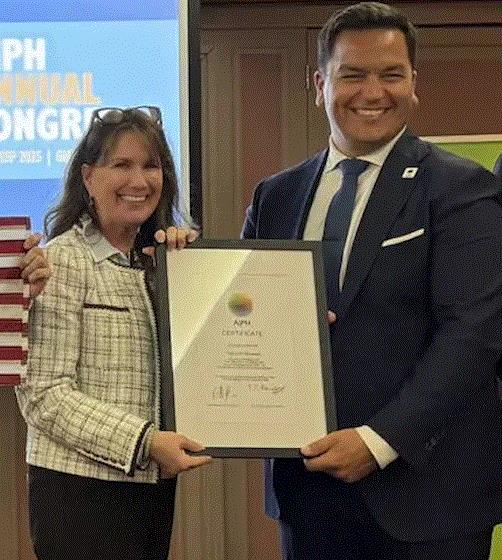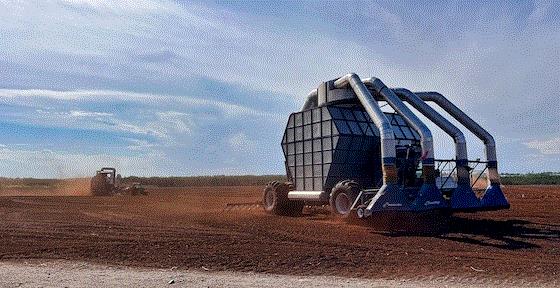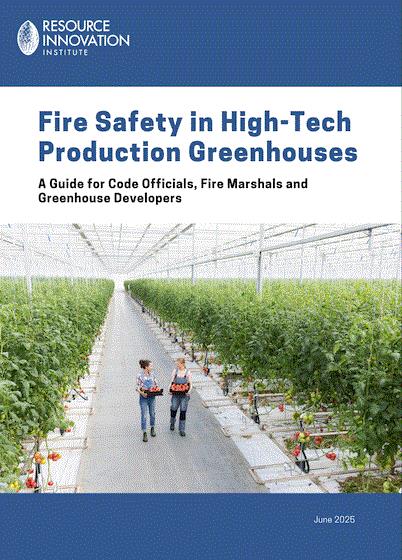Minnesota gets America’s First A1-rated Horticultural Expo
No, not A1 as in the steak sauce. A1 as in a major, large-scale global horticultural exposition—and Minnesota is getting the first one in America approved by the International Association of Horticultural Producers (AIPH). The six-month-long Expo 2031 Minnesota is planned for May 1 to October 15, 2031, in Dakota County (home of Minneapolis-St. Paul). By the time the opening ribbon is cut, it will have been a 10-year effort.
“Think of an A1 Expo as the ‘World Cup of horticulture,’” said Rachel Wakefield of AIPH. “A rare, global event lasting up to six months where countries create spectacular gardens and exhibits.”
No word on how many countries will participate; at least 10 are required to meet AI standards. The last A1 event, Expo 2023 Doha Qatar, attracted 72 exhibiting countries.

Expo 2031 Minnesota CEO Wendy Meadley accepts the honor from AIPH President Leonardo Capitanio during AIPH's 77th Annual Congress in Ghent, Belgium.
“Provisionally” approved by AIPH and recognized by the Bureau International des Expositions (BIE), the organizers will continue working towards federal recognition, finalizing site and transportation plans, and expanding partnerships across the horticultural, agricultural and technology sectors.
This is a big deal that’s been in the planning stages since at least 2021. That explains why Wendy Meadley, CEO of Expo 2031 Minnesota, said, “This is more than a milestone; it is a celebration. What began as an application has become a movement, uniting leaders and communities across the United States and the world. With our federal partners, investors and horticultural community, we are ready to build a legacy event that connects cultures through the power of plants.”
Speaking of plants, two of Minnesota’s biggest horticulture companies have been involved: Bailey Nursery and Bachman’s. Bailey’s Ryan McEnaney is Board Chair; Susan Bachman West is Horticulture Advocate and Presenter. (I tried to reach Ryan for comment, but his out-of-office reply said he was taking personal time off until the 22nd. No doubt celebrating the news like Wendy!)

Expo 2031 Minnesota (continued)
Under the theme “Human/Nature: Where Humanity and Horticulture Meet,” Expo 2031 will be held on a 165-acre site near the Mississippi River. The master plan introduces five ecological zones—tropical, arid, temperate, continental and North Star—designed to represent growing conditions from across the world, giving visitors the chance to encounter plants they wouldn't normally see in Minnesota. The gardens and display will incorporate all USDA agricultural zones, ensuring that the country’s wide-ranging climates and crops are represented. While horticulture remains central, the Expo will connect plants to broader themes of agriculture, food production and supply, energy, water treatment, health and wellbeing, and future technology.
Some 4 million visitors are expected over the six-month run, with more than $2 billion in regional economic impact, but the site is being designed to leave a lasting legacy of permanent green spaces and educational facilities.
AIPH-approved A1 exhibitions have been held in the UK, the Netherlands, Germany, France, Turkey, Japan, China and Thailand.
The last big Expo in the U.S. (which was not AIPH-sanctioned) was the Louisiana World Exposition in New Orleans in 1984. An expo was planned for Columbus, Ohio, in 1992 (the 500th anniversary of Christopher Columbus), but funding fell short.
To learn more about Expo 2013 Minnesota and to keep up with developments, CLICK HERE.

Major Dutch grower closing down
I was stunned to learn this week that Bunnik Group, the parent company of Bunnik Plants, one of the Netherlands’ largest and best-known potted plant and foliage producers, has announced it's closing its doors as of March 31, 2026. The shutdown includes Bunnik Creations, their ceramics, decoration and packaging division, and their trucking and distribution division, Bunnik Logistics.
The third-generation business has seven growing locations in Bleiswijk, a ceramics factory in China and a Bunnik Creations USA sales office with warehouse in New Jersey, plus a sales office in Orlando. They employ about 160 people and in 2024 had sales of nearly $120 million. They produce anywhere from 600,000 to 1 million plants per week, depending on which source you believe.

The reason for the decision wasn’t specified in the company’s announcement, which stated, “Bunnik Group has faced disappointing sales results for years since the post-COVID period. Since then, margins on plants have been under severe pressure due to a combination of reduced demand and oversupply in the market. In addition to lower demand, Bunnik also deals with sharply increased costs for energy, sea transport and higher import tariffs.”
It went on to say that cost-cutting measures, and even an increase in market share via distinctive plant varieties, have not been sufficient.
I must say, those are pretty general headwinds that all large nurseries face—although certainly having multiple locations, plus having branched out into container manufacturing in China in 2004, puts an added stress and risk on the business. But isn’t every big grower in Europe operating under those same conditions of reduced demand, oversupply and high costs, especially energy? Might there be more to the story?

Bunnik (continued)
Knowing third-generation owner Dennis Bunnik a bit from my frequent trips to the Netherlands, I emailed him, hoping for a little more information. But this is all he was willing or able to say: “The decision was not easy, but the most important thing is that we, as a family, want to exit the stage with dignity, free of debt and with a solid reputation.”
It’s not easy closing a Dutch business due to strict worker rights protections, so Bunnik is doing a “controlled wind-down” of the company in conjunction with their banks to avoid bankruptcy. A controlled wind-down, says Google, is a “strategic and organized process for a company to cease operations, settle its financial obligations and liquidate assets … with the goal of maximizing value for stakeholders and minimizing disruption and financial losses.” To that end, they’ve stopped accepting orders and final deliveries will be in mid-2026.
As I mentioned, Bunnik is a third-generation business founded by Ferd Bunnik in 1945 growing vegetables under glass. Like many, he switched to floriculture in 1967, starting with aechmea bromeliads. Ferd’s three sons joined the business in 1981, and Dennis and his brother, Thomas, took the leadership reins in 2019.

Deroose’s answer to tariffs
My friend Paul Deroose, who started Deroose Plants in Apopka, Florida, in 1994 as a North American division of his family’s business in Belgium, is a smart businessman who isn't going to let a little thing like tariffs get him down … even though about 95% of his bromeliad young plants and other plant material comes from their own companies in China—meaning it’s subject to tariffs. I recently asked Paul how Deroose is coping and he told me a few interesting things:
- First, they can’t easily avoid high Chinese tariffs by moving their location to another country: “It would take years to achieve something like that and major investments.”
- Nor can they get around the tariff by first shipping to a low-tariff country: “Not possible, as the transit time is too long, the plants don’t survive and many countries do not allow re-exporting immediately.”
- Then they had a genius idea: Split the invoice into two invoices. “One for the plants only and one for handling service, packaging, documents, phyto and shipping. This second invoice with no plants is not subject to tariffs, so a significant amount of our normally tariffed goods are not tariffed.”

- Lastly, they took a gamble (that seems to be paying off). Paul said they buy in some bareroot foliage that they don’t grow themselves from other Chinese suppliers. Right after the tariffs hit 150% they met with their Chinese buying agent and considered canceling all new orders due to the high cost. But when the agent said that’s what all the other U.S. customers were doing, too, “… we decided to ship anyway, anticipating there would be a shortage in the market of sansevieria, Ficus Ginseng, pachira braids and some other things we bring in this way.”
He said they're now selling out—even at the higher post-tariff price—before the plants are even ready, as they're one of the few that have them.
“Sometimes I wish I had increased the supply—we would sell all of it.”
Yet another great example of that famous quote (usually mis-attributed to Einstein): “In the middle of every difficulty lies opportunity.”

Canadian peat: Some up, some down
Now that I’ve been to a peat bog, I know about the summer harvest season and the impact of rain. So curious about how 2025 is looking, I emailed Asha Hingorani, president of the Canadian Sphagnum Peat Moss Association, to get an update.
Asha (who happened to be at the Baltic Peat Producer Forum in Latvia), told me I have good timing, as the association just released its Canadian Horticultural Peat Extraction Report on August 31 (although many producers are still extracting peat, especially in the west, as conditions remain good). Here’s what the report says:
Overall, the 2025 results show that some regions reached their expected levels, while others did not due to the challenges of rainy weather in the start of the season and sustained wildfire conditions.
Alberta, Saskatchewan and Manitoba
Manitoba was above its targeted level of extraction at 109%. Saskatchewan (73%) and Alberta (87%) were below expected extraction levels. The summer had ideal extraction conditions, but with record heat and very dry conditions throughout July and August, producers remained cautious and diligently followed provincial rules and regulations regarding wildfires and peat extraction conditions.
Québec and Ontario
Québec’s South Shore (74%) and North Shore (82%) regions were below expected targeted levels due to the rainy conditions at the start of the extraction season, primarily in May and June. Ontario’s warm, dry conditions, especially towards July and August, allowed for extraction levels to reach 91% of expectations.

Harvesting peat in Quebec, 2024.
New Brunswick
In New Brunswick, the North (74%) and South (94%) regions came in below expectations in 2025 after record numbers in 2024. In many cases, producers reached their expected initial targets early in the season, as the conditions were ideal, however, the August wildfire season and the closure of Crown land limited extraction days in much of New Brunswick.
Nova Scotia, Prince Edward Island and Newfoundland
Across Nova Scotia, Prince Edward Island and Newfoundland (65%), extraction levels were below average due to rain and unfavorable conditions, including wildfires. Conditions improved towards August.
Thanks, Asha! Hmmm, so some regions are up, some are down and some are still harvesting. But it wasn’t a washout or disaster or I’d have been getting word from producers warning of potential shortages.
But, as always, check with your suppliers, be sure your order is in, and be a good and loyal customer to ensure a steady supply … and that goes for everything from plugs to pots to peat.

I hear it was rainy in the Baltics ...?
One of my peat-producing friends in Canada mentioned that the European peat supply may be challenged due to weather, so since Asha was there, I asked her what she knew. She couldn't provide any specifics, but she did connect me to the LinkedIn page of the Association of Growing Media Producers (formerly the Lithuanian Association of Peat Producers), where I found this sobering post:
“This year’s peat season has been one of the most difficult in decades. Only a third of the planned quantities have been harvested and in some places only 15%. This shows how vulnerable and strategically important our industry is now.
“The Baltic countries supply more than 40% of the global substrate market. Therefore, a shortage of raw materials here means not only price changes, but also a direct impact on the entire food supply chain.” (They mention food supply because of the amount of peat used in hydroponic vegetable systems, I am sure.)
Well, now we know: If you depend on European peat, you’d really better get in touch with your supplier!

Monarch Magic: Shoot a photo, win a prize!
Monarch Magic is a great new spreading ageratum from Ball FloraPlant and I think most everybody is growing and selling it. Which means you might have some around, busy attracting Monarch butterflies. If so, you should snap a photo or shoot a video because you could win one of three $100 Visa gift cards for your efforts!

The 2025 Monarch Magic Sweepstakes is open to the industry and the general public, and it runs from September 17 to October 1. Qualified submissions should contain photos and/or videos of monarch butterflies on or around Ageratum Monarch Magic plants.
How do you enter?
- Use Instagram, Facebook or LinkedIn and tag your images @ball.floraplant or
- Use THIS FORM to upload your photos and enter your information
Monarch Magic is a spreading ageratum with a vigorous habit that’s ideal for the landscape or larger baskets or containers. It’s a 2024 Colorado State University Outstanding Plants award winner, and is an ideal season-extender due to its drought tolerance and seasonal flower power.

P.L. Light Systems hires new marketing manager
Let’s give a big horticulture welcome to Caelin Williams! He’s an outsider coming into our industry and that’s always interesting for the fresh approaches he may bring to our little world of horticulture. As the new marketing manager for P.L. Light Systems, he'll be based out of their Hamilton, Ontario, headquarters. P.L. said they're confident Caelin can “push the boundaries of the P.L. Light brand.”

Caelin has more than a decade of experience in so-called “experiential marketing”—directly engaging the customer in the evolution of a brand. He’s got experience in content creation, digital marketing, social media, thought leadership and video production. Most recently he worked for Impact XM, a full-service experiential marketing agency with offices in Ontario, Chicago, Las Vegas, London, Denver and New Jersey.
While new to the greenhouse and CEA industry, Caelin said he's eager to gain expertise in horticultural lighting and apply his marketing skills to help grow the P.L. brand.

Finally …

I hate writing about greenhouse businesses going out of business, as I had to today—just as bad is writing about greenhouse fires, which I’ve had to do many times in my career. They always happen at the worst possible time (nights and right before a big holiday) and they can cause months and months of lost growing time (and revenue). But fires are preventable, which is why you should check out this handy guide: Fire Safety in High-Tech Production Greenhouses.
Published by the Resource Innovation Institute, this guide is designed to assist everyone from code officials and fire marshals, right down to greenhouse buildings and growers. Topics covered include fire suppression systems, exit and egress requirements, building classification considerations, fire detection and alarm systems, and practical implementation challenges.
You may know some of the experts who contributed their knowledge to the document: Matt Stuppy of Stuppy Greenhouses, Zack Bruce of Hortica and Mike Zee of Gotham Greens, along with other experts in greenhouse, engineering and fire safety.
Check it out HERE (just scroll down the page a bit). You’ll find other handy CEA guides at the same spot.




Feel free to email me at beytes@growertalks.com if you have ideas, comments or questions.
See you next time!

Chris Beytes
Editor-in-Chief
GrowerTalks and Green Profit
This e-mail received by 29,752 loyal readers!
Thanks to my loyal sponsors, who help me reach the 29,752 readers of Acres Online in more than 60 countries. Want to be one of them (a sponsor, that is)? Give Kim Brown a shout and she will tell you about our many advertising opportunities.